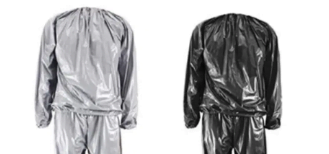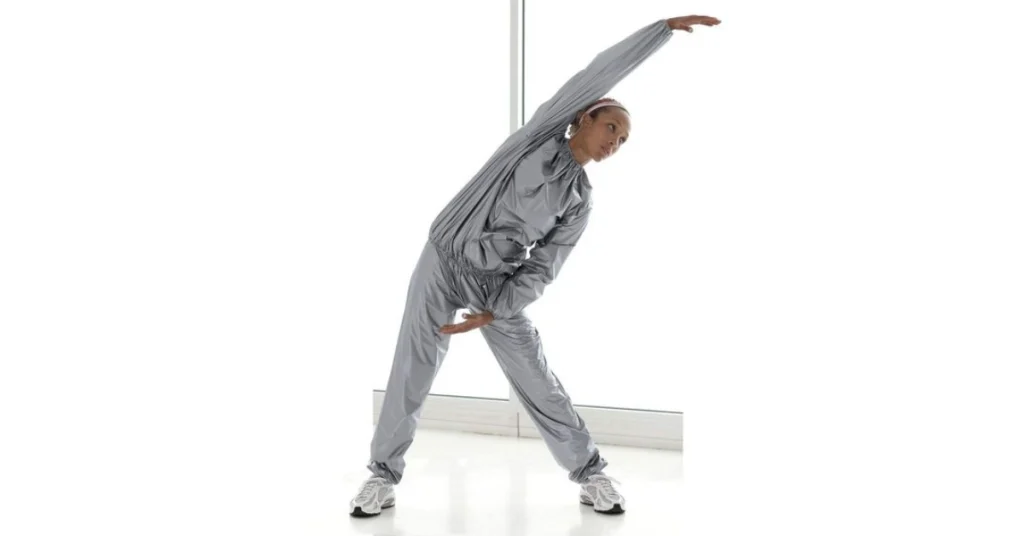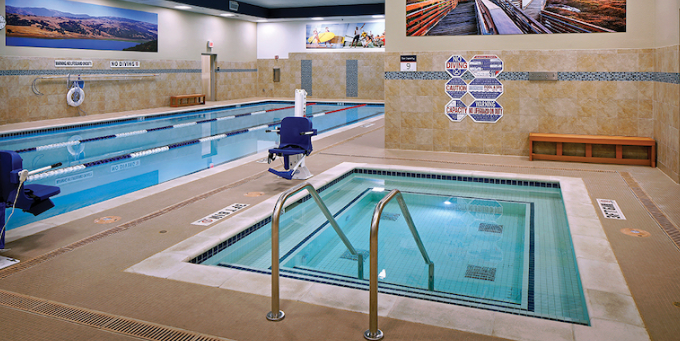I was testing my limits all over my workouts because using a sauna suit
increased the intensity of my sweating. But it also meant that I had to pay much closer attention to how my body
reacted and to staying hydrated. Many different types of people, such as regular exercisers, home workout
lovers, and professional athletes, love the spa suit.
This clothing item promises to help in weight loss and provide additional health advantages by recreating the
effects of a typical sauna. Continue reading to find out more about sauna outfits, including their uses,
advantages, and definitions.
What is a Sauna Suit?

An exercise outfit made up of waterproof material to trap body heat and promote perspiration is called a sauna suit, sometimes known as a sweat suit. This has many
benefits, such as the elimination of toxins, burning calories, and the development of muscle.
Although the precise history of sauna suits is unknown, individuals of all ages have been wearing them for a very
long time. Sweat suits, often known as rubber suits, were first created from rubbery fabric and have seen
significant growth over time.
Sauna Suit Material Options
for Losing Weight
These days, weight-loss sauna outfits are made of several different materials:
- Silver Polymer: This is a newly developed material that provides allergy-free, odorless,
thin, and comfy suits. Because of their remarkable retention of heat, which speeds up weight reduction, they
are strong and resilient to tearing. - Neoprene: Once valued for its softness, neoprene is gradually being replaced by current materials. Its strong smell remains
for a long time, and those who are allergic to the material may find it irritating to their skin, which
limits its charm to others. - PVC and nylon: Although PVC and nylon are less expensive, they are less durable and more likely to break. Not only
that, but they’re not very breathable, which could make exercising uncomfortable.
Here you can purchase the best Women’s & Men’s Sauna Hooded Jacket Sweat Suit for Exercise
and Heat Training, Neoprene.
Sauna Suit Styles and Sizes
Sauna suits are available in a range of styles and sizes to fit a variety of body shapes and preferences. With
sizes ranging from S to 6XL, everyone is sure to fit. Options for style include:
- Full-body outfits or those with bare arms and legs, give you the freedom to wear what you want.
- Offering complete coverage or flexibility, the top and lower bodies can be covered in one piece or separate
portions. - Compared to heavy-duty suits constructed of sturdy materials for durability, lightweight choices are more
economical but less durable because they are composed of lighter materials. - Designs with or without hoods; covered suits offer more heat retention, which is advantageous, particularly
in colder weather.
Steam room suits come in gender-specific versions with features customized to fit various shapes
and preferences, as well as universal designs.
How to Wear on a Sauna Suit?
There are many different designs of sauna suits, and each has particular wear requirements to guarantee optimal
comfort and efficiency:
- Take off all jewelry, paying special attention to the wrists and neck.
- Select the appropriate size from the variety offered to guarantee a tight fit.
- Put on form-fitting, moisture-wicking underwear below the sauna outfit to help control perspiration and
improve comfort. - Slide the thermal suit on over your underwear, tightening the elastic straps over your neck, wrists, and
ankles for the top portions, and waist and ankles for the bottom.
How Do Sauna Suits Work?
A recent study conducted by Lance Dalleck and colleagues found that sauna suits are a useful
tool for encouraging weight loss and other health advantages. Of the 45 study participants, the bath suit
wearers showed significant benefits above the normal gym wearers. Individuals who used sauna suits reduced their
body weight by a considerable 2.6%, whereas those who wore conventional gym attire only witnessed a 0.9%
decrease.
Furthermore, the group using hot tub suits showed a significant 13.8% drop in total body fat,
compared to an 8.3% fall in the group wearing normal gym clothes. Additionally, metabolic rates rose noticeably
by 11.4% in the sauna outfit group and very little by 2.7% in the usual gym gear group.
According to these results, using a sauna suit has both immediate and long-term health advantages. The hot tub
suit works by retaining the heat that your body generates while you work. Generally, exercise raises your body
temperature quickly, which leads to sweat. Your skin absorbs this sweating, which helps to cool your body by
expelling heat.
Sauna suit benefits

The following benefits of sauna suits are given below:
- Reduction of Weight: The main motivation for using sauna outfits is to help lose weight.
Sauna suits accelerate water loss by raising body temperature and causing heavy sweating. This is especially
useful for athletes who have to gain weight to compete. It’s crucial to remember that weight loss is mostly
the result of water loss rather than fat loss. - The process of detoxification: One of the body’s natural detoxification processes is
sweating. Sweating more when wearing a thermal suit can speed up this process. Sweating helps your body rid
itself of toxins and pollutants, which may enhance your general health and well-being. - Improved Condition of the Heart: You can simulate the benefits of moderate aerobic activity by wearing a spa suit. Wearing the suit can
eventually improve the cardiovascular system due to the raised heart rate and circulation.
This is especially advantageous for people who might not be able to work out at a high intensity. - Enhanced Efficiency during Exercise: Workouts in sauna outfits can become difficult since
they need the body to work harder to cool off. When exercising in this way as opposed to when not wearing
the suit, you may burn more calories. Furthermore, the warmth could help in increasing strength and
flexibility.
Safety Points to Remember
Sauna suits have many advantages, but it’s important to use them properly to prevent health risks.
- Drink plenty of water: When wearing a sauna suit, dehydration presents a serious risk.
Staying hydrated during and after your workout requires consistently consuming large amounts of water.
Drinking alcohol and caffeine together can cause dehydration, so stay away from them. - Rashes on the Skin: Sauna suits’ non-breathable fabrics might lead to rashes or skin
irritation. To reduce the suit’s direct skin contact, use the moisture-wicking apparel below. To stop smells
and bacterial growth, keep the suit dry and clean. - Gradual Progression: When using a thermal suit for the first time, begin with brief,
low-intensity exercises. As your body adjusts, gradually increase its length and intensity. By using this
strategy, you can reduce your chance of becoming dehydrated and overheated. - Heat-related: Another issue with utilizing a thermal suit is overheating. Pay attention to
your body and cease exercising if you experience lightheadedness, dizziness, or extreme exhaustion. It’s crucial to
exercise in a cold setting and hold off on high-intensity exercises until your body adjusts to the suit. - Health difficulties: Before utilizing a sauna suit, those with specific health
difficulties, such as high blood pressure, heart disease, or respiratory problems, should speak with a
doctor or nurse. The elevated body temperature and higher cardiac stress could make these symptoms worse.
Exercise in a Sauna Suit

It’s crucial to take these actions after wearing your sauna suit to reduce the risks related to the high heat
before beginning your workout:
- It’s important to drink enough water before starting a sauna suit workout. Six ounces of water should be consumed right before you begin, and you should keep
drinking water every ten to fifteen minutes while doing out. - While working out in a sauna suit, pay attention to your body’s signals. If something feels off, stop right
away, and drink more water to replace lost fluids. - Following your exercise, you can either use the sauna suit’s heat (especially in colder climates) or
instantly take it off for comfort. - If you’ve never used a sauna suit, start your workout slowly. Start with shorter workouts (around 20
to 30 minutes) and less heavy exercises. You can extend and intensify your workouts with time,
but don’t go above 45 minutes of intense exercise. - If you have severe skin allergies, diabetes, or hypertension, it’s best not to use a sauna suit as it can
worsen discomfort or other health problems. - Take into consideration taking off the sauna suit in the shower to help control perspiration and hygiene,
and wash the suit right away following each use.
Maintenance and Safety
Your sauna suit’s durability and efficacy depend on proper maintenance.
- Washing: Following the company’s directions, wash the sauna suit after each usage. Most
suits are cleanable with a moist cloth or a light soap and water wash. Stay clear of harsh cleansers and
aggressive chemicals as they can harm the material. - Drying: Before storing the sauna suit, let it air dry fully. Stay away from heat sources
and direct sunshine since these could damage the material. Drying properly aids in preventing the growth of
mold and fungi. - Keeping: Keep your sauna suit somewhere dry and cool. It is best not to fold it tightly
since this might lead to wrinkles and eventually weaken the cloth. To preserve the suit’s structure and
shape, hang it if you can.
Conclusion
Thanks to fat oxidation and a host of other advantages, sauna suits
are useful workout equipment for improving health and touching the target weight. As this article emphasizes,
choosing the right type of clothing and wearing it efficiently is key to optimizing the benefits of sauna suits.
Other considerations to make include material, quality, and style.







